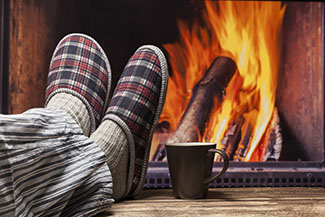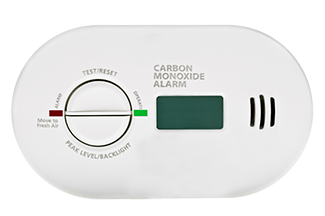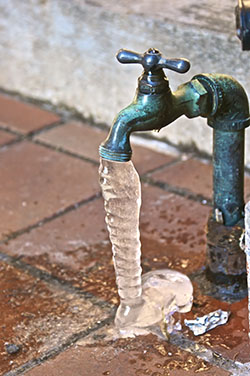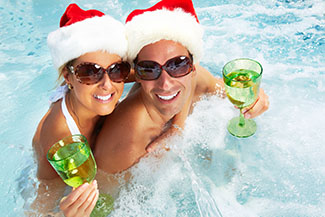Surviving The Cold by Maintaining Your Heating Equipment
prep your house from freezing, get the hot tub ready, carbon monoxide testing
For most Arizonans south of Yavapai County and north of Cochise County, the heater is typically turned on by December. The next few months, we will bundle up under fleece blankets, with our sweats and bunny slippers.
Regardless of where you live in Arizona, these tips will keep you toasty until the end of February (unless you are in Flagstaff or Rim Country).

Heating Units
Central Heat
If you did not do this by mid-November, do it now, as in right now – schedule an appointment with an HVAC company to ensure your heating system is ready to be turned on.
Chuck Knight, Knight Air Conditioning, suggests biennial HVAC service. "If you have a gas heat, you should absolutely have your system looked at least once a year. Especially here in Arizona where we don't use gas heat that much, it's important to keep an eye on it. Things you don't take care of end up needing care. We check all those things to make sure you are not cold or don't wake up." (See below.)
Although we are focusing on heating, an important deadline regarding HVAC systems is coming up. R22 refrigerant is a chemical that keeps the air coming from the air conditioning system cool. Most air conditioning units older than 10 years use R22, also known as Freon. Beginning January 1, 2020, all production and import of R22 will be eliminated. Only recycled R22 refrigerant will be available to service existing air conditioners after 2020.
That doesn't mean you won't be able to get it. There are warehouses filled with pallets of R22 because the industry knew this was coming. The price will likely go up, but it's a lot cheaper than replacing the whole unit. You can also use recycled product. Chuck uses Rapid Recovery who filters R22 and resells it a at reduced price.
Chuck suggests that If you have an R22 system, fix anything except a compressor or leak. "You can do a $200 worth of repair with $1,000 worth of refrigerant going back into it. But if it leaks once, it will leak again. If you do a second repair, you've just bought your system."
Podcast
Weekly To-Do #SurvivingTheCold found at 19:00 minute mark. Chuck Knight of Knight Air Conditioning on maintenance of your heating system. Chuck also clears up the January 1st ban on R-22 Freon in air conditioning units and what it REALLY means for your HVAC unit.
Space Heater
Most electric space heaters are very inefficient and expensive to run. They are fine for a small space like under a desk but are inefficient and costly for warming a room.
Before using it, follow these safety guidelines:
- Plug the space heater, especially the one in the bathroom, into a ground-fault circuit interrupter (GFCI).
- Don't hide the electric cord under rugs or carpet. The cord could overheat and cause a fire.
- Leave three feet of space between the heater, furniture and, walls.
- Keep it away from anything flammable.
- Never plug a space heater into an extension cord.
- Use fuel-burning space heaters only when someone is awake to monitor them.
- Never use a gas stove or oven to heat your home.
- Use portable gas camp stoves outdoors only.
- Keep a nearby door or window are open to provide fresh air. Seems counterproductive. See "Carbon Monoxide" below.
Carbon Monoxide Detectors
 Carbon monoxide poisoning can happen any time of year, though with the use of gas-fired heaters in the winter months the risk is more common. Carbon monoxide is a colorless, odorless, and tasteless gas produced by burning gasoline, wood, propane, charcoal or other fuel in an improperly ventilated space.
Carbon monoxide poisoning can happen any time of year, though with the use of gas-fired heaters in the winter months the risk is more common. Carbon monoxide is a colorless, odorless, and tasteless gas produced by burning gasoline, wood, propane, charcoal or other fuel in an improperly ventilated space.
According to the Mayo Clinic, these are the signs and symptoms of carbon monoxide poisoning:
- Dull headache
- Weakness
- Dizziness
- Nausea or vomiting
- Shortness of breath
- Confusion
- Blurred vision
- Loss of consciousness
Signs in the home:
- stuffy or stale air
- condensation on windows
- yellow burner flames on the stove
- fluttering or extinguishing pilot lights
Prevention:
- Get a yearly checkup for all gas appliances, including the furnace from the utility company.
- Place a detector on every floor of the house.
- Keep detectors at least 15 feet away from a gas stove or oven.
- Replace the batteries in your alarms per the manufacturer's instruction.
- Properly maintain gas appliances and devices.
- Avoid idling your car in the garage.
- Use gas appliances as recommended.
- Don't run a generator in an enclosed space, such as the basement or garage.
- Check vents and chimneys to make sure they are not covered by tarps or debris.
- Keep fuel-burning appliances and engines properly vented areas.
If there are signs or your alarm sounds, turn off suspected appliances, open doors and windows, call a natural gas contractor and get out of the house.
Once carbon monoxide poisoning has occurred, you must find and repair the source of the carbon monoxide before you stay there again. Call your local fire department or utility company for assistance.
A note about replacing batteries in detectors, Rosie on the House Certified Partner, Tekna Security & Smarthome suggests using lithium ion batteries. However, ALWAYS defer to the manufacturer's recommendations. They may have a specific type such as alkaline or silver oxide that is suited for a particular brand or model.
Fireplaces

Before lighting the first fire of the season, clean and inspect the fireplace. In the off-season, birds and other critters may have used the chimney as a home. For gas fireplaces, Rosie on the House Certified Partner, Arizona Chimney & Air Ducts, suggests they are inspected for obstructions in the flue pipe and the damper has a stop on it. An inspection will ensure all the gases are escaping up and out the chimney as well as prevent carbon monoxide poisoning.
Additional Fireplace Safety:
- Don't burn trash. Smoke and ashes can be toxic.
- Don't use charcoal lighter or kerosene to light the fires as it could flame up.
- Use a spark screen while burning, and a grate to lay the wood upon.
- Be sure the damper is open before lighting the fire.
- Never leave small children unattended with an active fire.
- Never leave the house or go to bed while the fire is burning.
- Keep furniture and anything combustible (Christmas tree) away from the fireplace.
Pipes
Pipes in Arizona can freeze. When water freezes in a pipe, it expands and the pipe can burst, resulting in serious damage. Rosie on the House Certified Partner, Day and Night Plumbing offers these steps to prevent pipes from freezing.
If you will be away from home for days at a time, make sure that all of your pipes are kept warm, especially in spaces that receive little or no heat. If any pipes will stay exposed to freezing temperatures, only leave faucet slightly open to allow drip - but best practice is to wrap and insulate pipes.
Hot Tub
Oh yeah . . . a soak in the hot tub is a great way to relax in the winter. To keep it in good working order, follow these steps as provided by Jacuzzi.com. If your hot tub is not a Jacuzzi brand hot tub, be sure to double check with your tub's manufacturer for instructions.
Drain the hot tub and give it a thorough scrubbing, including the vents and filters. Be sure to use cleaning products suggested by the manufacturer. Then refill it with water.

If you live in a very cold area, run your hot tub in F3 "Standard" mode. A sensor will monitor the climate and periodically run the pump when the temperature drops below a certain level, preventing anything from freezing.
Keep the cover firmly on it when not in use. This will keep the heat in, preventing you from running the heater continuously and saving you money in the long run.
Maintain the chemicals during the winter even if the tub is not being used regularly.
The recommended temperature for hot tub use is 102°F. Our bodies do not adapt well to extreme and quick changes in temperature. As hard as it can be to get out of a blissful soak, sessions should not last more than 30 minutes. Otherwise temporary shock, dizziness, or fainting can occur. Follow the same safety guidelines as you would for pool use.
Drain the hot tub and give it a thorough scrubbing, including the vents and filters. Be sure to use cleaning products suggested by the manufacturer. Then refill it with water.
If you live in a very cold area, run your hot tub in F3 "Standard" mode. A sensor will monitor the climate and periodically run the pump when the temperature drops below a certain level, preventing anything from freezing.
Keep the cover firmly on it when not in use. This will keep the heat in, preventing you from running the heater continuously and saving you money in the long run.
Maintain the chemicals during the winter even if the tub is not being used regularly.
The recommended temperature for hot tub use is 102°F. Our bodies do not adapt well to extreme and quick changes in temperature. As hard as it can be to get out of a blissful soak, sessions should not last more than 30 minutes. Otherwise temporary shock, dizziness, or fainting can occur. Follow the same safety guidelines as you would for pool use.
Home Maintenance To-Do | #SurvivingTheCold
###
Photo Credits:
- Shutterstock
RELATED CONTENT:
- Blog: Winter Warmth & Indoor Heating
- Blog: How To Handle Freezing Pipes
- FAQ: How Can I Prevent My Pipes From Freezing?
- FAQ: What Are The Best Reasons To Clean My Gas Fireplace?
- FAQ: What Are The Best Rules For Fireplace Safety?
- FAQ: What's The Safest Way To Use My Fireplace?
- FAQ: What Safety Precautions Should I Take With My Gas Fireplace?
- FAQ: Where Should I Install Carbon Monoxide Detectors?
- FAQ: Gas Fireplace Logs: vented or Vent-Free?
- FAQ: Let Safety Rule Around The Pool
- Podcast: Plumbing Maintenance, Water Saving And Gas Fitting Appliances
- Hot Tub/Spa: The Sensible Way to Enjoy Your Spa or Hot Tub
- Mayo Clinic: Carbon monoxide poisoning
